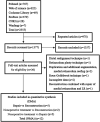Comparing Nonoperative Treatment, MPFL Repair, and MPFL Reconstruction for Patients With Patellar Dislocation: A Systematic Review and Network Meta-analysis
- PMID: 34604425
- PMCID: PMC8485172
- DOI: 10.1177/23259671211026624
Comparing Nonoperative Treatment, MPFL Repair, and MPFL Reconstruction for Patients With Patellar Dislocation: A Systematic Review and Network Meta-analysis
Abstract
Background: Medial patellofemoral ligament (MPFL) reconstruction, MPFL repair, and nonoperative treatment are important treatments for patients with patellar dislocation. However, it is unclear which treatment leads to better outcomes.
Purpose: To determine the efficacy and safety of the 3 treatments in the treatment of patellar dislocation and compare the effect of MPFL reconstruction with MPFL repair, MPFL reconstruction with nonoperative treatment, and MPFL repair with nonoperative treatment.
Study design: Systematic review; Level of evidence, 3.
Methods: The PubMed, Web of Science, Cochrane Library, Embase, CNKI (China National Knowledge Infrastructure), and Wanfang databases were searched from inception to December 2020. Included were clinical studies that described the efficacy and safety of 2 of the 3 treatments, studies directly comparing the clinical effects of the 2 operative techniques, or studies comparing the effects of reconstruction or repair with nonoperative treatment. Two reviewers independently extracted data and assessed the quality of the included studies with the Cochrane risk-of-bias tools. The outcomes evaluated were postoperative redislocation rate, revision rate, complications, and Kujala score. We used traditional direct pairwise meta-analysis as well as network meta-analysis for comprehensive efficacy of all 3 treatment measures.
Results: Twelve studies were included: 5 compared MPFL reconstruction with MPFL repair, 2 compared MPFL reconstruction with nonoperative treatment, and 5 compared MPFL repair with nonoperative treatment. The risk of bias was serious in 4, moderate in 4 and low in 4 articles. MPFL reconstruction led to significantly reduced redislocation and improved Kujala scores compared with MPFL repair and nonoperative treatment. MPFL repair led to reduced redislocation rates compared with nonoperative treatment but did not show an obvious benefit in primary dislocations. There was no significant difference among the 3 treatments in terms of revision rate and incidence of complications, although we found that treatment-related complications were least likely to occur in nonoperative treatment.
Conclusion: The results of this review indicate that MPFL reconstruction decreases recurrent dislocation compared with MPFL repair or nonoperative treatment, but it has a higher possibility of complications. MPFL repair resulted in less postoperative redislocation than nonoperative treatment but did not show an obvious benefit in primary dislocation.
Keywords: MPFL; medial patellofemoral ligament; network meta-analysis; nonoperative; patellar dislocation; reconstruction; repair.
© The Author(s) 2021.
Conflict of interest statement
One or more of the authors has declared the following potential conflict of interest or source of funding: Funding was received from the National Natural Science Foundation of China (81874017, 81960403, and 82060405); Natural Science Foundation of Gansu Province of China (20JR5RA320); Cuiying Scientific and Technological Innovation Program of Lanzhou University Second Hospital (CY2017-ZD02, CY2017-QN11, CY2020-BJ03); Traditional Chinese Medicine Inheritance and innovation platform construction project (TCM-IPC-2020-03); and Lanzhou science and technology development guiding plan project (2019-ZD-58). AOSSM checks author disclosures against the Open Payments Database (OPD). AOSSM has not conducted an independent investigation on the OPD and disclaims any liability or responsibility relating thereto.
Figures
Comment in
-
First case report on persistent patellar dislocation in haemophilia A patient with a factor VIII inhibitor.Haemophilia. 2022 Sep;28(5):e113-e116. doi: 10.1111/hae.14606. Epub 2022 Jun 17. Haemophilia. 2022. PMID: 35714656 No abstract available.
References
-
- Ahmad CS, Shubin Stein BE, Matuz D, Henry JH. Immediate surgical repair of the medial patellar stabilizers for acute patellar dislocation. A review of eight cases. Am J Sports Med. 2000;28(6):804–810. - PubMed
-
- Arendt EA, Moeller A, Agel J. Clinical outcomes of medial patellofemoral ligament repair in recurrent (chronic) lateral patella dislocations. Knee Surg Sports Traumatol Arthrosc. 2011;19(11):1909–1914. - PubMed
-
- Askenberger M, Bengtsson Moström E, Ekström W, et al.Operative repair of medial patellofemoral ligament injury versus knee brace in children with an acute first-time traumatic patellar dislocation: a randomized controlled trial. Am J Sports Med. 2018;46(10):2328–2340. - PubMed
-
- Berard JB, Magnussen RA, Bonjean G, et al.Femoral tunnel enlargement after medial patellofemoral ligament reconstruction: prevalence, risk factors, and clinical effect. Am J Sports Med. 2014;42(2):297–301. - PubMed
-
- Bitar AC, Demange MK, D’Elia CO, Camanho GL. Traumatic patellar dislocation: nonoperative treatment compared with MPFL reconstruction using patellar tendon. Am J Sports Med. 2012;40(1):114–122. - PubMed
Publication types
LinkOut - more resources
Full Text Sources
Medical


